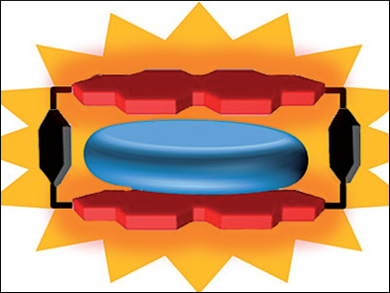Macrocylic molecules comprising large functional π systems are of particular interest as they can accommodate large organic guest molecules such as dyes or organic semiconductors. Frank Würthner and Peter Spenst, University of Würzburg, Germany, have synthesized cyclophanes comprising two perylene bisimide (PBI) units with para-xylene bridges. This molecular design overcomes the problem that short spacers do not provide sufficient space for guest molecules and that long flexible spacers result in aggregation of the PBI units.
The PBI cyclophane was tested as a host for both electron-rich and electron-poor organic molecules. The researchers found that complexation of electron-rich guests (such as carbazole) resulted in fluorescence quenching of the host, whereas complexation of electron-poor guests (such as phenylnaphthalene) resulted in a complex with a higher quantum yield than the host.
Binding studies showed that guests with more carbon–carbon double bonds bound more strongly to the host. This system has an ideal interchromophoric distance for the effective binding of a range of hydrocarbons, and thus can be used as a “turn-off” and “turn-on” sensor for electron-rich and electron-poor hydrocarbons.
- A Perylene Bisimide Cyclophane as a “Turn-On” and “Turn-Off” Fluorescence Probe,
Peter Spenst, Frank Würthner,
Angew. Chem. Int. Ed. 2015.
DOI: 10.1002/anie.201503542




